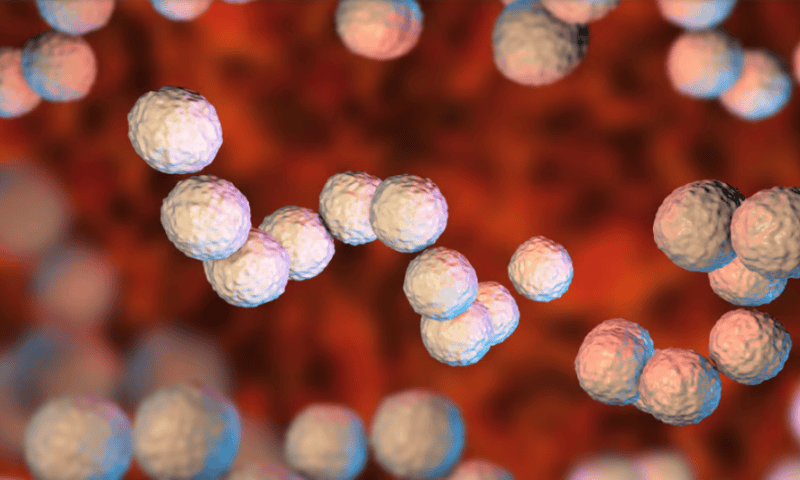Flesh-eating bacteria sound like something an enterprising science fiction author would dream up, but they are, in fact, real—and the infections they cause can lead to disfigurement, loss of limbs and even death.
Flesh-eating infections “are very difficult to treat and are life-threatening,” microbiologist Michael Caparon, Ph.D., of Washington University in St. Louis, told Fierce Biotech in an interview. Current antibiotics are often ineffective, because they can’t reach the bacteria well enough to have an effect.
Caparon and colleagues have been working on a new antibiotic that has proven effective when pitted against certain bacteria in lab conditions. Now, they’ve put it to the test against a real, living infection, and found that it reduced the size of flesh-eating bacteria infections and sped up healing in mice. The results were published in Science Advances on Aug. 2.
The “flesh eating” these bacteria cause is really necrotizing fasciitis, and it happens when the microbes infiltrate under the skin and begin destroying the connective tissue that surrounds muscles. A common culprit is Streptococcus pyogenes, which can also cause strep throat and milder skin infections called impetigo.
Caparon and microbiologist Scott Hultgren, Ph.D., also of Washington University, originally teamed up to study how a bacteria called Enterococcus faecalis causes urinary tract infections in people with catheters, one of the most common infections that patients contract in hospitals. They realized that the catheter irritates the bladder and causes bladder cells to release a wound-healing molecule called fibrinogen, which builds up on the catheter and is a target for E. faecalis to latch on to.
Hultgren had previously worked with a chemist from Umeå University in Sweden, Fredrik Almqvist, to develop compounds that stop a different bacteria, E. coli, from binding to surfaces. Caparon and Hultgren decided to test out whether the synthetic compounds made by Almqvist’s group could also stop E. faecalis from binding to catheters. Instead, the drugs killed the bacteria altogether.
“We got the result we wanted, but for a different reason,” Caparon said. Further tests found that all the gram-positive bacteria (like E. faecalis) they exposed to the compounds were killed, while gram-negative bacteria (like E. coli) were spared. Accordingly, they dubbed the drugs GmPcides.
“Gram-positives include a lot of important pathogens,” Caparon said, including antibiotic-resistant bacteria like methicillin-resistant Staphylococcus aureus (commonly called MRSA) and vancomycin-resistant enterococci (known as VRE).
Once the GmPcides had proved their mettle in test tubes, Caparon and Hultgren gave one of the drugs—called PS757—it’s biggest challenge yet. PS757 was developed by Almqvist’s collaborator at Umeå University, Pardeep Singh, Ph.D. Working in Caparon’s lab, Zongsen Zou, Ph.D., took a mouse model that, when injected with S. pyogenes, develops infectious ulcers and treated it with injections of PS757.
PS757 “dramatically reduced the amount of tissue damage that the ulcer causes,” Caparon said. In addition to developing smaller infections, treated mice also healed faster than untreated mice. By 12 days after infection, 15 of the 20 treated mice had shed the scab that grows over these ulcers and replaced it with new, healthy skin, whereas only four of 19 untreated mice showed that level of wound recovery.
What’s more, PS757 also showed that it could kill S. pyogenes biofilms grown in a test tube. Biofilms occur when bacteria glom together into a gooey agglomeration, slow down growth and form a protective matrix around themselves. Penetrating this matrix with antibiotics is tough, and, even if you do, many antibiotics are only effective against bacteria that are actively growing and dividing.
A “useful feature reported of these drugs is action against resting, nondividing cells,” microbiologist Christopher LaRock, Ph.D., of Emory University, told Fierce Biotech in an email. These cells are “hard to target with many common drugs, and thought to be important for drug failure, prolonged disease, and recurrence.”
LaRock, who was not involved with the study, thinks PS757 would work best in combination with other antibiotics. Caparon said the team is hoping the new compound can work alone but is also testing it in combination; in prior work, the researchers found that sublethal levels of GmPcides, when used with vancomycin, could kill VRE.
PS757 seems to be killing the bacteria by damaging their cell membranes, the protective layer that separates the inside of a cell from the outside world. But how exactly it does this is a mystery that Caparon is actively working to solve. Advancing PS757 and other GmPcides as drugs is the task of QureTech Bio, a Swedish biotech founded by Almqvist and Hultgren.
“Once you have a lead compound that’s effective, you want to make and test as many different variants based on that lead compound to optimize various drug-like properties,” Caparon said. “That’s something that can be done much more efficiently in the setting of a company than we can in an academic environment.”

